Fantasy Football 2025: RB Jerome Ford player profile

By
- Nick Chubb’s injury spurred opportunity: Jerome Ford stepped into a larger role with the Cleveland Browns due to Chubb’s injury in 2023, showcasing his potential as a reliable fantasy option in committee backfields.
- Rookie additions cloud future: Ford’s path to fantasy relevance in 2025 faces challenges as the Browns have brought in two new rookie running backs, creating uncertainty about his role.
- Subscribe to PFF+: Get access to player grades, PFF Premium Stats, fantasy football rankings, all of the PFF fantasy draft research tools and more!
Estimated Reading Time: 5 minutes

PFF’s Fantasy Football Player Profile series delivers the most in-depth fantasy football analysis available for the 2025 season.
Using PFF’s exclusive data, we evaluate player performance, competition for touches and how teammates and coaching staffs
Last updated: 7:15 a.m. Sunday, June 22
Player performance
Jerome Ford was a fifth-round pick by the Browns in 2022 but spent his rookie season fourth on the depth chart, behind Nick Chubb, Kareem Hunt and D’Ernest Johnson. While Ford barely played as a rookie, the Browns opted not to re-sign Hunt or Johnson, moving Ford up to the top backup for 2023.
Chubb suffered a season-ending injury in Week 2, leading to Ford being a primary running back for the rest of the season. The team re-signed Hunt, so it was generally a two-man backfield. Ford played in passing situations, Hunt played in short-yardage and goal-line situations, and the two split early-down snaps.
Ford ran 16 times for 106 yards and a receiving touchdown in Week 2 and scored twice in Week 3, giving him two top-10 fantasy finishes. However, Ford only finished as a top-12 fantasy running back two more times the rest of the season and only three other times as a top-20 running back. He spent most weeks right around RB24. Ford combined decent receiving volume with decent rushing volume to finish 25th in fantasy points per game among running backs.
The Browns again didn’t re-sign Hunt in 2024 but knew Chubb wouldn’t be ready for the start of the season. Cleveland added D’Onta Foreman to share the backfield with Ford until Chubb was ready. Ford spent the first five weeks averaging 11.9 fantasy points per game, which was in line with 2023. He spent one week at RB8, another at RB18 and the rest outside of the top 24. He was injured in Week 6 and missed two games. When Ford was back, Chubb was also healthy.
Ford was primarily a passing-down back for the first few weeks, but as it became more clear Chubb wasn’t going to be effective, Ford became more involved in the run game again. He averaged nine carries per game over his last four healthy games. This led to two top-10 performances in his final two healthy games.
Ford has improved as a runner each season, particularly when it comes to making more big plays. Ford gained at least 30 yards on 1.9% of his carries, tied for the third among running backs last season. Over the previous two seasons, he avoided 0.23 tackles per carry, seventh among running backs.
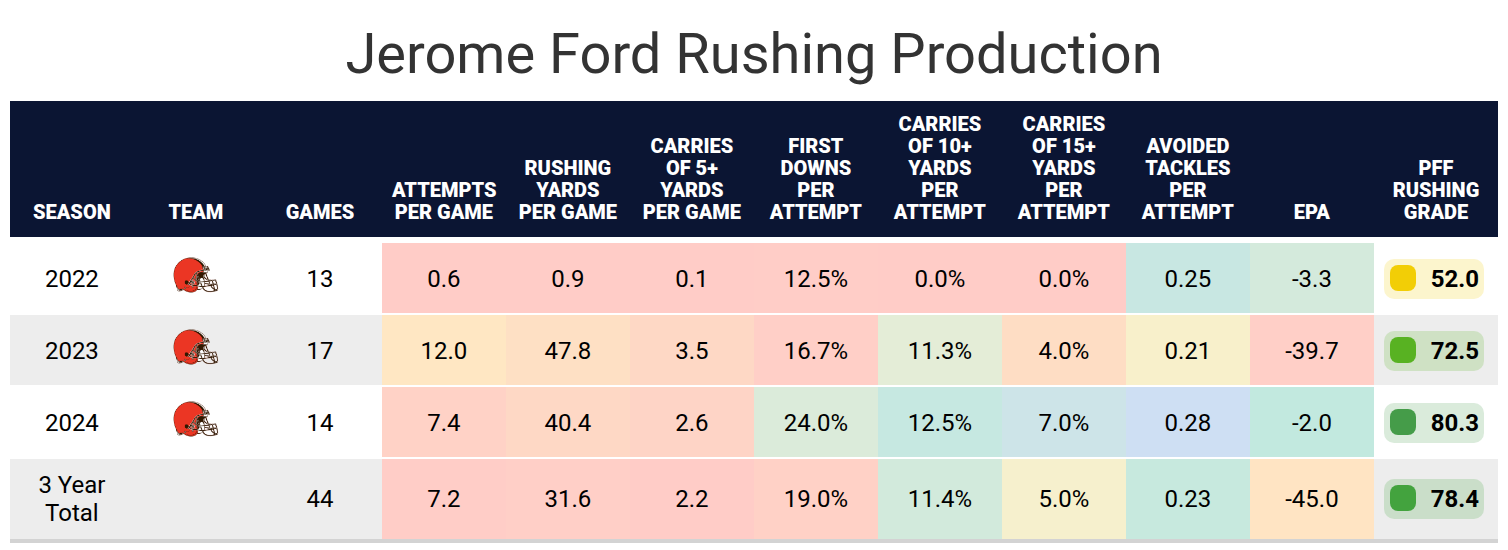

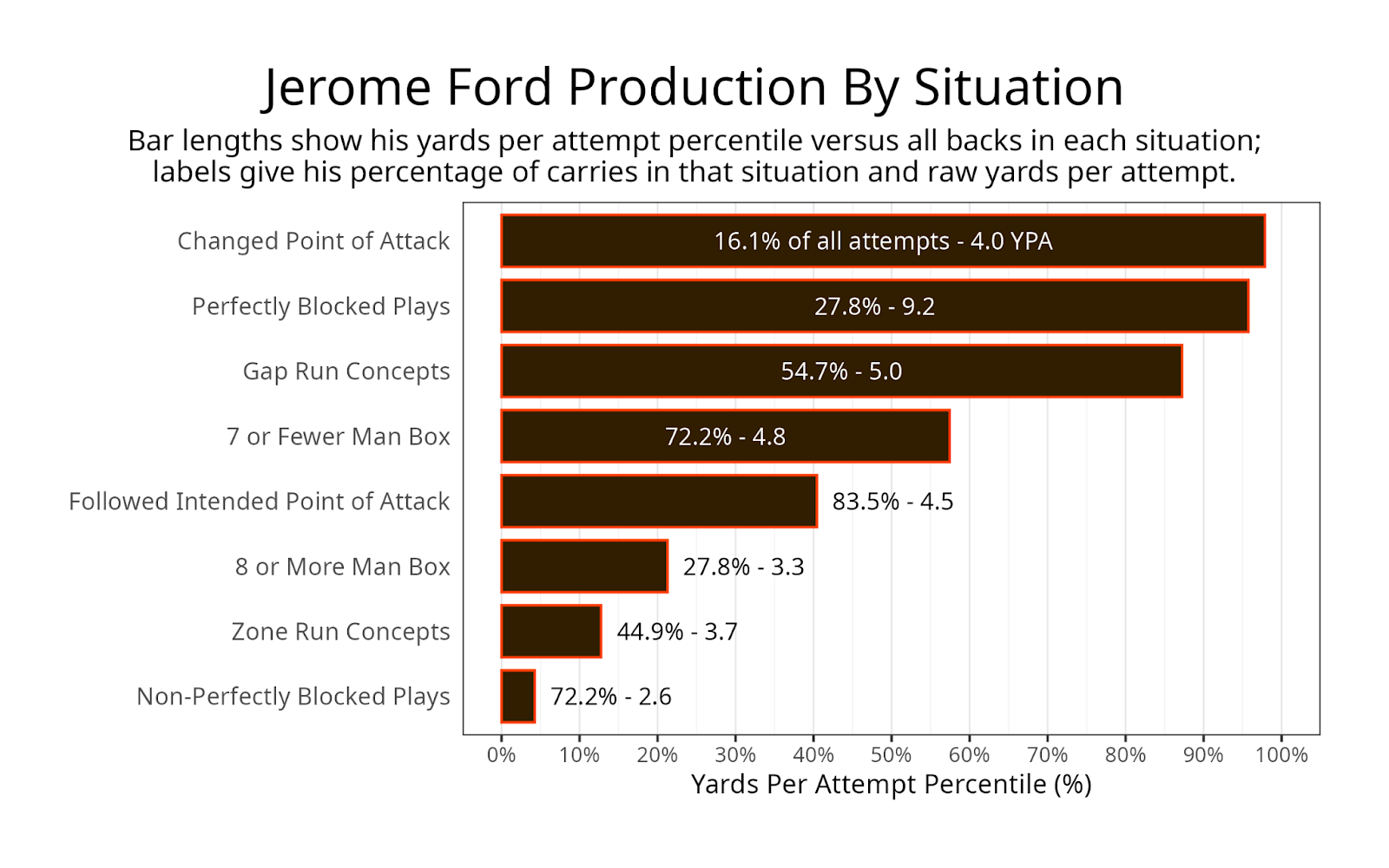
Projected role
The Browns moved on from both Chubb and Foreman this offseason but spent their second-round pick on Quinshon Judkins and their fourth-round pick on Dylan Sampson. After the draft, Ford accepted a pay cut to remain with the team.
Judkins was excellent as a rusher in college, and at Ohio State, he primarily played the early-down role. Sampson is a smaller running back, and while he’s capable of big plays in the run game, the Browns will likely use Sampson in some passing situations.
This could mean that Ford is out of luck for a major role in the offense. Ford has also made some big plays in the run game but so have Judkins and Sampson in college. Ford has the most experience in the passing game, but he hasn’t been effective as a receiver. Ford has also been a below-average pass protector, so he might not even see a large third-down role simply for his pass protection.
While Ford might not see much playing time without an injury, Ford would likely see a significant role if there is an injury to Judkins ot Sampson. At that point, things would be similar to the last two seasons.

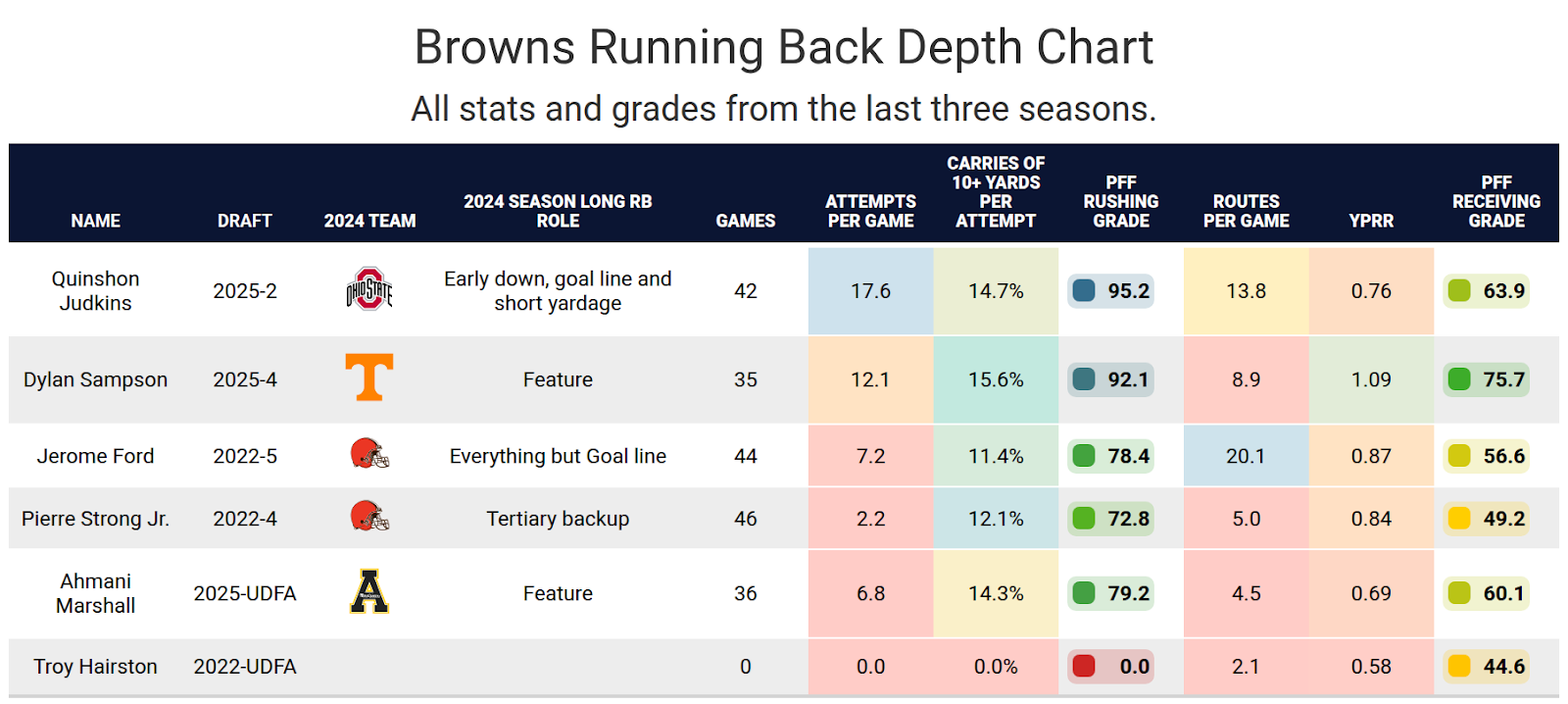
Impact of teammates
Ford will continue playing in Kevin Stefanski’s offense, as he’s done throughout his career. Strefanski’s offenses have consistently had a high play count, which has been helpful. However, he’s consistently used a committee approach at running back and doesn’t target his backs much in the passing game. There is a chance his lack of every-down back had more to do with Chubb than it does Stefanski, but if he’s fine with a feature back, that back will be Judkins and not Sampson.
The biggest concern for the Browns’ running backs, outside of the rotation, is the offensive line. At its peak, it was arguably the best line in the league. Cleveland has stuck mainly with the same players, who have progressively declined. Joel Bitonio, Wyatt Teller and Jack Conklin all had run-blocking grades above 85.0 just a few years ago but were below 62.0 last season and will be at least 31 years old by the end of the season. Ethan Pocic’s run-blocking grades never reached those heights, but he’s graded below 70.0 in the run game each of the last two seasons, and he will be 30 years old before the start of the season. That leaves Dawand Jones as the only offensive lineman under 30 years old, and he’s never reached a 60.0 run-blocking grade in a season.
Cleveland added guard Teven Jenkins and tackle Cornelius Lucas in free agency. They were paid like backups, but it wouldn’t be surprising to see either crack the starting lineup this season. They would be upgrades. Ford has averaged 9.2 yards per carry on perfectly blocked runs compared to 2.6 on non-perfectly blocked runs. It’s possible Ford would have a chance to prove he can be a starter in the NFL if he were playing behind a better line.
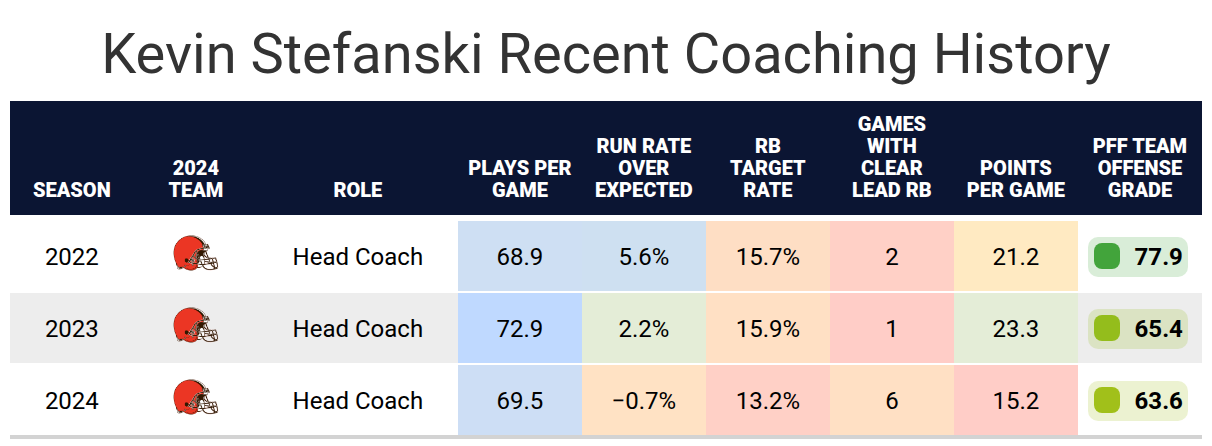
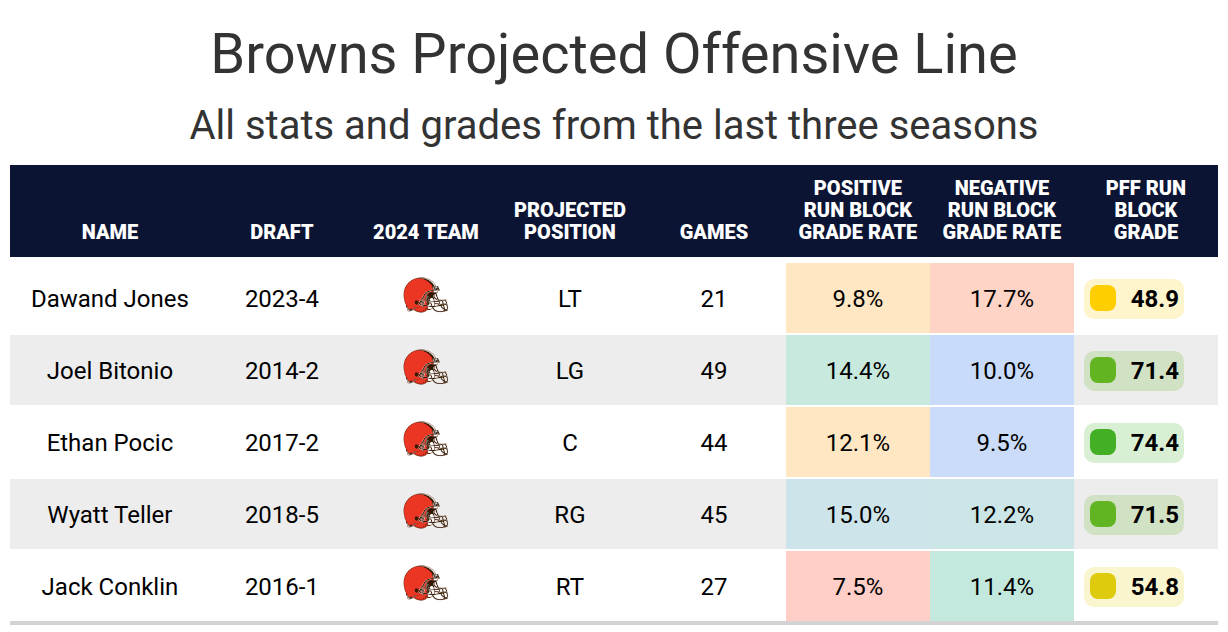
Bottom line
Ford is unlikely to have fantasy value this season unless the rookie running backs disappoint or deal with injuries. Even then, Ford would only be a borderline fantasy starter if he earns a significant role.

Footnotes
- Statistics in tables and charts were chosen based on their ability to predict future fantasy performance on a per-game or per-opportunity basis or to describe the player relative to others at the same position.
- “Opportunities” are defined as passing dropbacks, rushing attempts and routes run as a receiver.
- Numbers are provided either by season or based on the past three years. For rookies, only college statistics are included. For non-rookies, only NFL statistics are considered, regardless of whether they played in college within the previous three years.
- As college competition is easier than NFL competition, most rookies are likely to see a decline from their historical numbers.
- Only FBS data is considered for college players and comparisons.
- Kneel-downs are removed from rushing data to provide cleaner quarterback rushing rate statistics.
- The table colors in this article range from blue (indicating good/high) to red (indicating bad/low).
- All percentiles and color codings compare the given player to others with a high sample of opportunities. Generally, the cutoff is one-third of the possible opportunities in the sample. If a player does not meet the threshold, they are still included in the comparison, though their results may appear better or worse than expected due to the smaller, less predictive sample size.
- Information on utilization classifications and their importance can be found here for running backs, wide receivers and tight ends.




